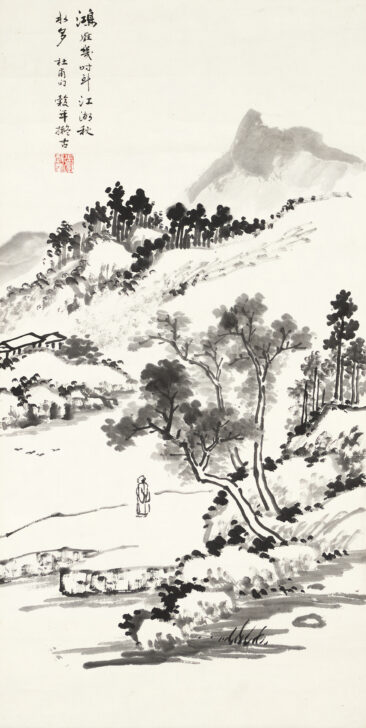Watching Geese
Chang Ku-nien

Description
This is an imaginary landscape in the Chinese literati (amateur scholar-artist) style. A lone scholar stands in a clearing on a mountainside looking up towards a small flock of geese; his pose mirrors that of the viewer standing before the work, who is invited to join the scholar in contemplation. The peacefulness of the subject and the traditional style belie the fact that the artist lived during a period of dramatic change, both political and artistic. Chang Ku-nien probably created this painting to convey a
longing for his home country and old friends. His inscription quotes a couplet from the famous Tang dynasty (618–907) poet Du Fu (712–710): “It’s autumn season. Waters are abundant in rivers and lakes, but when will the geese arrive?” The swan
goose (Anser cygnoides) migrates south in the autumn. It is a common metaphor for correspondence in Chinese literature, usually expressing homesickness or nostalgia for an old friend. Du Fu was missing his friend Li Bai (701–762), another famous poet.
Spring/Summer Gallery Rotation 2015
----------------
Chang Ku-nien
China, 1906–1987
Watching Geese
last quarter of 20th century
Hanging scroll, ink on paper
Gift of Dr. Cheng-Yang and Mrs. Shirley Chang, 2006/1.124
Solitary Leisure in a Quiet Pavilion
1974
Hanging scroll, ink and color on paper
Gift of Dr. Cheng-Yang and Mrs. Shirley Chang, 2006/1.108
Rain Ceases and Clouds Disperse
1974
Hanging scroll, ink and color on paper
Collection of Ted and Syauchen Baker
Old Music Tone, based on a Tang Poem
1985
Hanging scroll, ink and color on paper
Collection of Dr. Cheng-Yang Chang
Landscapes by literati artists frequently did not depict actual places. Instead they are “landscapes of the mind” that offer a lofty and idealized retreat from the troubles of the mundane world and invite the viewer’s meditative thoughts. These four imaginary landscapes in the literati mode—whether they closely imitate earlier literati masters or loosely allude to them—evoke an atmosphere of seclusion, one that is often reinforced by poetic inscriptions from classical poetry in Chang’s fine xingshu ?? (running-script calligraphy). The human presence in these serene landscapes is limited to a solitary scholarly figure sitting alone or strolling and gazing towards flying geese, or implied by a secluded hut or a lone resting boat.
Gallery Rotation Spring/Summer 2011
China, 1906–1987
Watching Geese
Last quarter of 20th century
Hanging scroll, ink on paper
Gift of Dr. Cheng-Yang and Mrs. Shirley Chang, 2006/1.124
Like the adjacent painting, this is an imaginary landscape in the Chinese literati style. In it a lone scholar stands in a clearing on a mountainside looking up towards a small flock of geese; his pose mirrors that of the viewer standing before the work, who is invited to join the scholar in contemplation. The peacefulness of the subjects of both paintings and their traditional style belies the fact that the artist lived during a period of dramatic change, both political and artistic. Chang was born in mainland China in the last years of the Qing dynasty (1644–1911), but in 1911 an armed revolution ended two millennia of imperial rule and established the Republic of China, ushering in the modern age and decades of political upheaval. After the 1949 Communist takeover of China, Chang resettled in Taiwan. Throughout this time he practiced and creatively adapted the literati mode of painting in political and social circumstances never imagined by his forbears. He was instrumental in the revival of the practice of traditional Chinese painting in Taiwan, where it had languished under the cultural influence of Japan during the years of occupation.
Subject Matter:
This landscapes is painted in the style of literati, an enduring tradition that for the most part shaped the artistic forms of landscapes painted by traditionally educated men for centuries. The scene described is in the spirit of Tang poet Du Fu's poem. A man watches the flying geeze alone. This is a common metaphor for nostagia for an old friend.
Physical Description:
This landscape makes use of the wide range of tones possible from black ink and water. A man stands in a mountain clearing, gazing at geese in the distance. Calligraphic text is written vertically in the upper left corner.
Usage Rights:
If you are interested in using an image for a publication, please visit https://umma.umich.edu/request-image/ for more information and to fill out the online Image Rights and Reproductions Request Form.